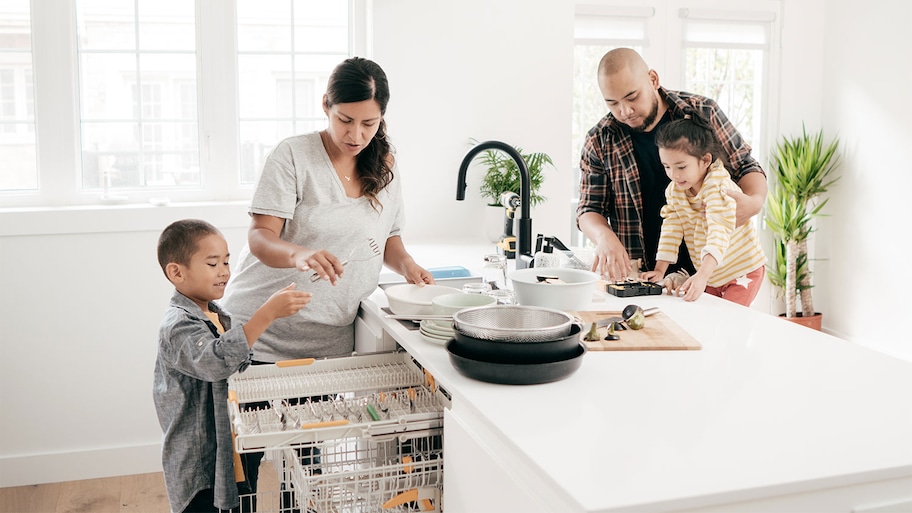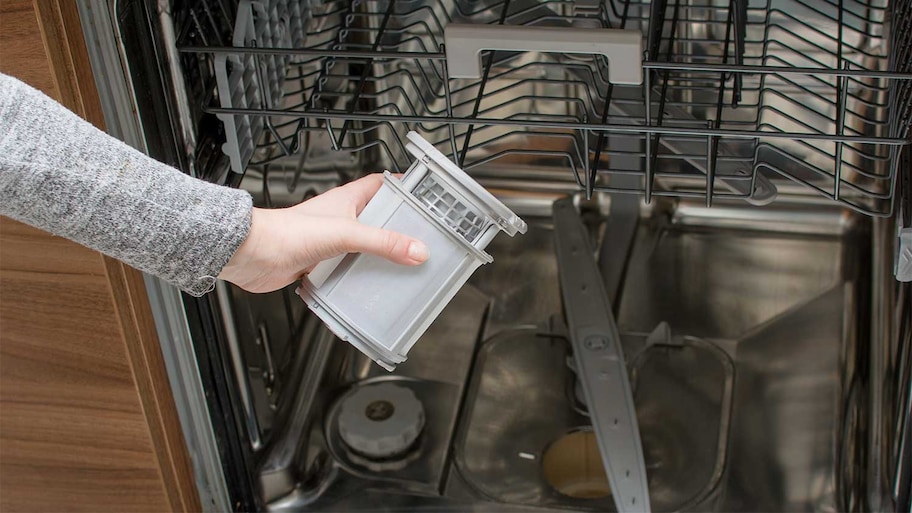How to Unclog Your Dishwasher Quickly and Easily
Get your dishwasher back up and running all on your own


You’re finishing up dinner for the night and begin doing the dishes—only to be greeted by a puddle of water, thanks to a clogged dishwasher. Luckily, you can usually take care of this problem in about 30 minutes. By cleaning your filter and pouring a DIY solution down the drain, you can clear most blockages.
Before calling a plumber, follow the steps in this guide to learn how to unclog your dishwasher and clear the dishwasher drain.
Why Do Dishwashers Get Clogged?
Dishwashers can become backed up thanks to bits of food or even mineral deposits from your water. While the latter is harder to control, if you’re dealing with a dishwasher that is frequently clogged, giving your dishes a good scrape before tossing them into the dishwasher is always a good idea. Remember, no need to rinse dishes thoroughly before putting them in the dishwasher, but getting rid of any spaghetti noodles or hardened cheese will help.
A dishwasher is usually clogged in one of two places: at the filter or the drain hose. While both should be fairly simple to deal with, a clogged filter can be prevented by regular cleanings.
Prepping to Unclog a Dishwasher
First, you’ll want to pull out your dishwasher manual to learn where the filter is and how to take it out if you don’t already know. While most dishwasher filters are located at the bottom beneath the spray arm, knowing more about your exact machine can save you time and ensure you do maintenance properly.
You’ll also want to remove the bottom dish rack and any standing water before getting to work. Lay towels on the floor around your machine as you remove the water with a cup and bucket. Soak up any remaining water inside the machine with a towel to ensure you’ll stay dry during your troubleshooting.
5 Ways to Unclog a Dishwasher
Try each step in order to help get to the bottom of your dishwasher clog. If the clog is cleared, you don’t need to continue to the next step.
Clean the Filter

Reach into your dishwasher, and remove the filter. Most dishwasher filters are cylindrical, and you can pull them out with a simple clockwise twist.
Once you remove it successfully, clean the dishwasher filter by running water over it in your kitchen sink. Clear out any food debris or grease residue with a soft bristle brush or cleaning cloth. Be sure to clean the inside and outside of the filter.
Put your filter back in and twist it into its proper position. Run your dishwasher on a rinse cycle to see if it drains.
If you notice that your filter has damage, such as a tear or hole, or it doesn't come clean, it’s time to replace it.
Pour a Safe Cleaning Mixture Into the Dishwasher Drain
If cleaning your filter didn't unclog the dishwasher, your drain hose may have a buildup of debris and grease.
Mix a solution of 4 tablespoons of baking soda with 4 tablespoons of white vinegar. Pour the mixture down the interior drain of your dishwasher. Let it sit for 15 minutes to break up any clogs and debris. Then pour a cup of hot water down the drain to flush out the hose and any remaining residue.
Run your dishwasher on the rinse cycle to see if you fixed the clog.
Clear the Garbage Disposal
Dishwashers often drain via the garbage disposal. If your disposal has excessive food debris or grease residue, turn it on for 30 seconds while running the water to help clear it out. If things don’t clear up, you may need to take a few minutes and unclog your garbage disposal.
Clean the Air Gap
Don’t have a garbage disposal? The clog may originate in your sink’s air gap cylinder located below your kitchen sink near the dishwasher’s drain hose. It usually looks like a cylinder with two slots towards the top. An air gap cylinder helps water to flow in the right direction during dishwasher cycles.
Remove your air gap by turning it counterclockwise. Clean out any grease buildup or food residue before resecuring it and running your dishwasher on a rinse cycle.
You may also find the air gap is chipped or worn away. If so, you can purchase a replacement from a hardware store or call an appliance repair pro to fix for you.
Unblock a Clog in the Drain Hose

If cleaning the filter, drain hose, or garbage disposal doesn’t fix your clog, you may have a more significant block in your drain hose. Before attempting a fix, turn off the dishwasher from its power source, either by shutting off the circuit breaker to the dishwasher or unplugging it from the wall.
Place a bucket underneath your sink near the pipes to catch any water or spills when you disconnect the drain hose from the pipe. Disconnect the hose fastener with a flathead screwdriver.
Clear any clogs by wiggling an auger or a straightened wire hanger inside the end of the hose. Drain hoses are soft and flexible, so be gentle when loosening debris so you don’t perforate or damage the drain hose. Reattach the hose once done and ensure it’s secure.
Plug your dishwasher back in or turn the breaker back on. Run a rinse cycle on high heat to help flush out any remaining debris.
Ways to Prevent Clogs in Your Dishwasher
You can reduce the chance of a dishwasher clog by performing regular maintenance and following a few tips.
Rinse all dishes and utensils to remove large pieces of food before placing them in the dishwasher.
Remove stickers and labels from your dishes or food containers before washing them.
Check and clean your dishwasher filter once every three months.
Run a hot water cycle once every three months to remove debris and residue buildup.
Deep clean the interior and exterior of your dishwasher to keep it in good working order.
Unclogging the Dishwasher Yourself vs. Hiring a Pro
You can unclog the dishwasher yourself with a few household products, usually costing less than $10. If your dishwasher still doesn't drain or the fix is more complicated, contact a plumber near you to prevent water damage or damage to your dishwasher.
The cost of a plumber ranges from $45 to $200 per hour or $300 on average for a dishwasher repair.
Frequently Asked Questions
Water is sitting at the bottom of your dishwasher, likely because the filter is dirty with food debris or because the drain hose has a clog. If the water is still sticking around after following the steps above, it’s time to contact a local plumber.
No, you cannot use a drain cleaner in a dishwasher, as it can damage your drain hose or dishwasher. After using a drain cleaner, you may experience leaks or mechanical issues. You may need to replace your drain hose or other parts of your dishwasher.
You should clean you dishwasher at least once a month. A clear sign that your filter needs cleaning is a musty smell even after your run a wash cycle. Failure to clean your dishwasher filter regularly can result in food buildup and clogging over time.
Yes, regular monthly cleaning is important if you use your garbage disposal daily. If you only use it sparingly, you can sometimes go up to six months without having to clean your garbage disposal. You can easily clean a garbage disposal by adding baking soda and and white vinegar down your drain, letting sit for 10 minutes, and then running your water.
Your dishwasher drain hose may have a clog if your dishwasher is full of water, your dishes aren’t getting cleaned, or water takes a long time to discharge into the garbage disposal.

